Martin P.M. Handbook of Deposition Technologies for Films and Coatings, Third Edition: Science, Applications and Technology
Подождите немного. Документ загружается.

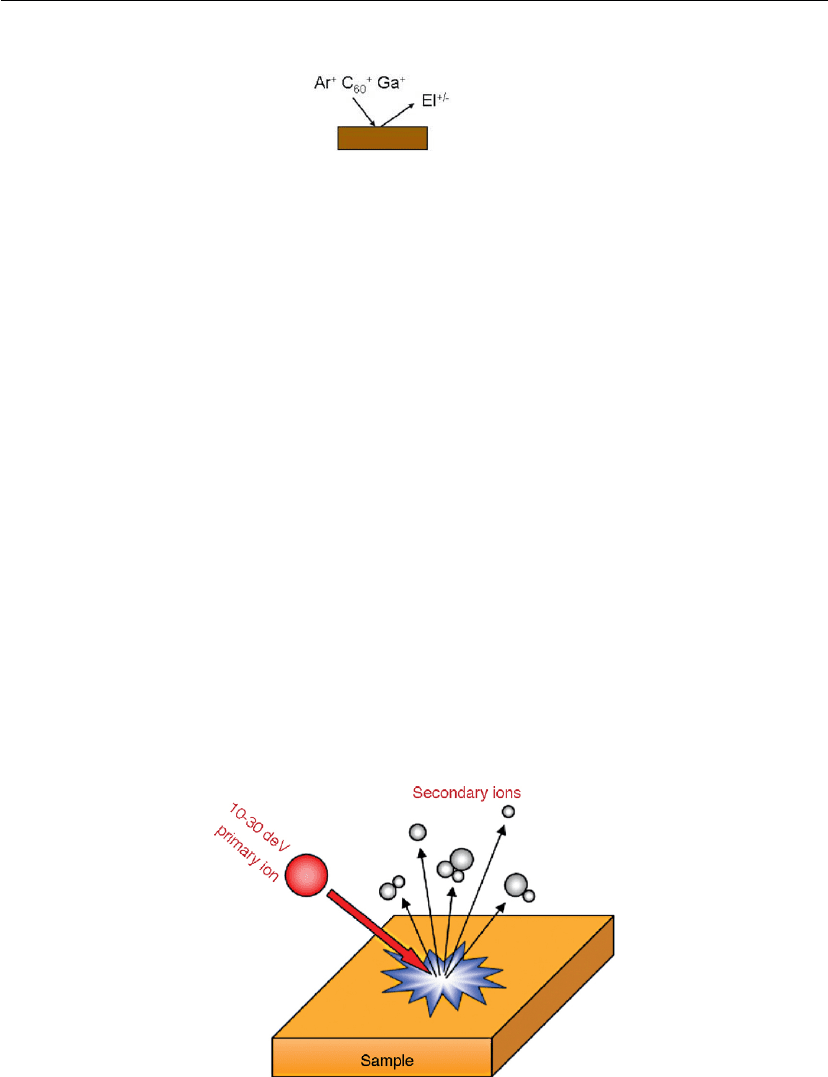
Characterization of Thin Films and Coatings 801
16.4.2 Secondary Ion Mass Spectrometry
Z. Zhu
Secondary ion mass spectrometry (SIMS) is a very powerful surface analysis technique, which
has been widely used in the semiconductor industry, materials research, environmental
research, biological research, and catalysis research. Quite a few review papers and books
addressing the details of this technique and its applications have been published [95, 96].In
general, secondary particles and clusters are generated as a result of the sputtering effect
(Figure 16.32) when an energized primary ion beam (normally 10–30 keV) impacts a sample
surface. Most of the secondary particles and clusters are neutral, but about 1–5% of them are
charged ions. These secondary ions can be collected and analyzed so that a mass spectrum can
be obtained.
The first generation of practical SIMS instruments was developed in the 1950s and 1960s.
They used a continuous primary ion beam, with a magnetic sector as a mass analyzer. This
kind of instrument was primarily used in depth profiling impurities in semiconductor materials,
such as Si and GaAs wafers. The current of the primary ion beam is commonly in the nA to A
range, so that materials can be sputtered away quickly (0.01–1 nm/s). Such use is now known
as ‘dynamic SIMS’, and currently it is the standard technique used to monitor impurities in
semiconductor materials. Dynamic SIMS has extremely high detection limits, from parts per
billion (ppb) to parts per million (ppm), depending on the specific element and sample.
Figure 16.32: Schematic description of the SIMS principle.

802 Chapter 16
Dynamic SIMS cannot be considered as a pure surface analysis technique since it removes
materials from surface very quickly. However, it is a very useful method to obtain information
about film and layer composition, diffusion and implant profiles, and the structure of
interfaces.
In the 1970s, Benninghoven developed the ‘static SIMS’ technique. A very low current
(picoampere level) pulsed primary beam was used to replace the continuous primary beam so
that ion-induced damage was very limited and the surface could be considered to be in a ‘static
state’. At the same time, Time-of-flight (TOF) mass analysis technique and single ion counting
electronics were incorporated into the instrumentation. Thus, almost all secondary ions can be
collected and detected. A useful mass spectrum can be easily obtained in a relatively short
time before the total ion dose reaches the static limit, approximately 10
12
ions/cm
2
.
TOF-SIMS has become the most commonly available SIMS technique in surface analysis
laboratories.
The primary capability of TOF-SIMS is to provide surface mass spectra. A mass resolving
power of 10,000 is not difficult, and such power is very useful for accurate mass peak
assignment and enables the identification of molecular or atomic species of nominally the
same mass. The top panel in Figure 16.33 shows a positive ion mass spectrum from an
oxidized silicon wafer surface. We can see Si
+
, SiO
+
,Si
2
+
, and Si
2
O
+
peaks, indicating Si and
O atoms as the major surface components. The bottom panel in Figure 16.33 shows a negative
ion mass spectrum of a sucrose film on a silicon substrate. The molecular peak with isotope
peaks strongly suggest that sucrose molecules stay on top of the surface.
One of TOF-SIMS’s unique capabilities is elemental/molecular mapping. Currently, most
primary ion sources are liquid metal guns, and the primary ion beam can be focused into
∼100 nm diameter so that high lateral spatial resolution image can be provided. Figure 16.34
shows a ZrO
+
ion image and Ni
+
ion image in a fuel-cell electrode, which is composed of
micrometer-size yttria-stabilized zirconia (YSZ) grains and nickel oxide grains. From the
image, it is easy to distinguish different grains and their relative positions.
TOF-SIMS can also perform depth profiling. However, since the primary ion beam current is
very low, a second sputtering beam, which has adequately high current (10 nA to 1 A), is
introduced. This strategy is called dual-beam depth profiling. Compared with the magnetic
mass analyzer in dynamic SIMS, dual-beam TOF-SIMS depth profiling has a relatively low
sensitivity, normally one to two orders of magnitude lower than that of dynamic SIMS.
Nevertheless, this sensitivity is adequate for most depth profiling requirements. At the same
time, the function of dynamic SIMS instruments is so specific that only a few semiconductor
companies and research institutes use them. Therefore, TOF-SIMS depth profiling is
becoming more and more popular in many areas of scientific research.
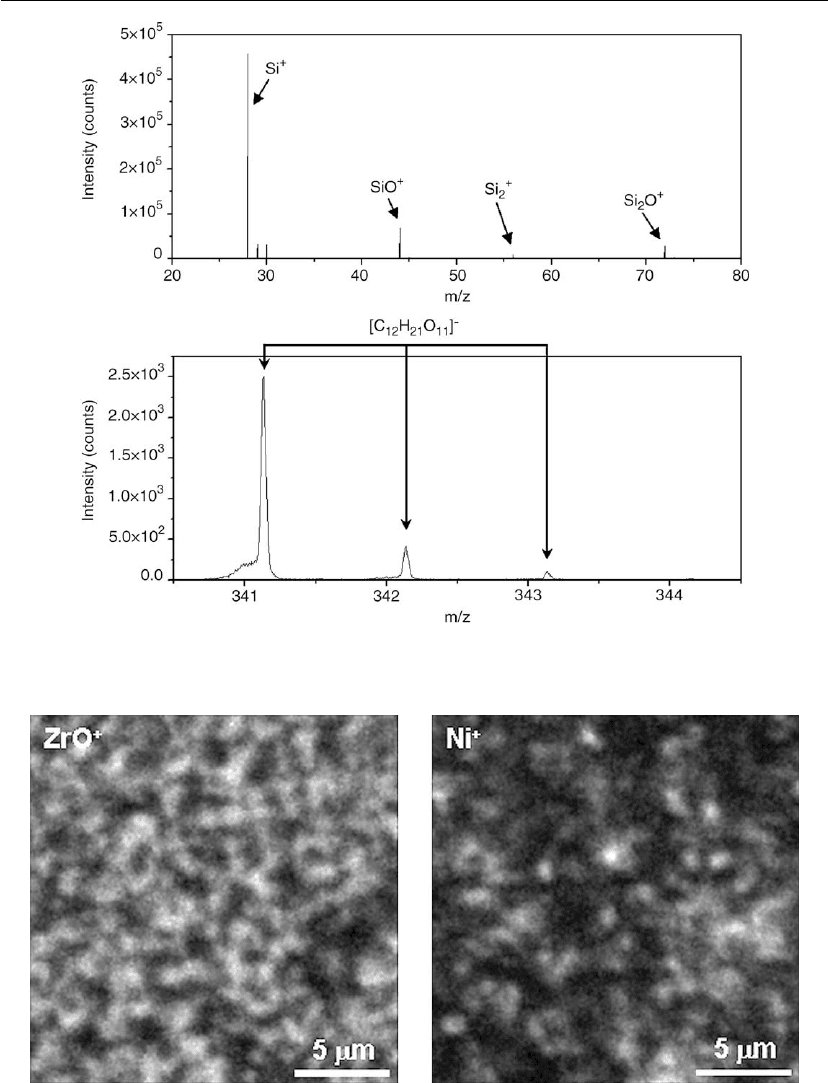
Characterization of Thin Films and Coatings 803
Figure 16.33: Top: positive ion spectrum of an oxidized silicon wafer surface. Bottom: negative
ion spectrum of sucrose (cane sugar) film.
Figure 16.34: SIMS images of a fuel cell electrode which is composed of yttria-stabilized zirconia
grains and nickel oxide grains.

804 Chapter 16
Table 16.4: Brief comparison of XPS, Auger, and TOF-SIMS
Elemental
information
Elemental
valence state
Molecular
information
Elemental
sensitivity
Lateral
resolution
Quantitative
analysis
TOF-SIMS Yes No Yes < 0.0001% 100 nm Needs reference
samples
XPS Yes Yes No ∼0.1% 10 m Directly
Auger Yes Yes No ∼1% 10 nm Directly
XPS and Auger spectrometry are two of the most popular surface analysis techniques, so it is
useful to compare TOF-SIMS with them. Table 16.4 shows the relative strengths of these three
techniques. From this table, it is easily found that three major advantages of TOF-SIMS are
isotope information capability, molecular information capability, and extra-high sensitivity.
Two major disadvantages are lack of elemental valence information and inconvenience of
quantitative analysis. Therefore, TOF-SIMS is normally used in the following situations:
if isotope information is required;
if molecular information is required;
if element/molecular concentrations are lower then 0.1% or 1%;
if reasonably high lateral resolution (down to 100 nm) elemental/molecule mapping is
required.
In recent years, great developments have been made in biological applications of TOF-SIMS
[97]. Cluster ion sources such as Au
n
+
,Bi
n
+
, and C
60
+
have been commercially available and
they can enhance organic molecular ion signals by one to three orders of magnitude. In
particular, a C
60
+
beam can sputter through quite a few organic, polymer, and biological
materials without significant damage, so that molecular depth profiling is feasible. It is
anticipated that TOF-SIMS applications in biological research will become more extensive
during the next decade.
Strengths:
High isotope sensitivity.
Provides elemental information with high spatial resolution.
Widely used technique for elemental mapping and depth profiling in the TOF mode.
Limitations:
Damages the sample surface (partly avoided by using lower sputter beam currents).
Lacks quantitative and chemical state information.
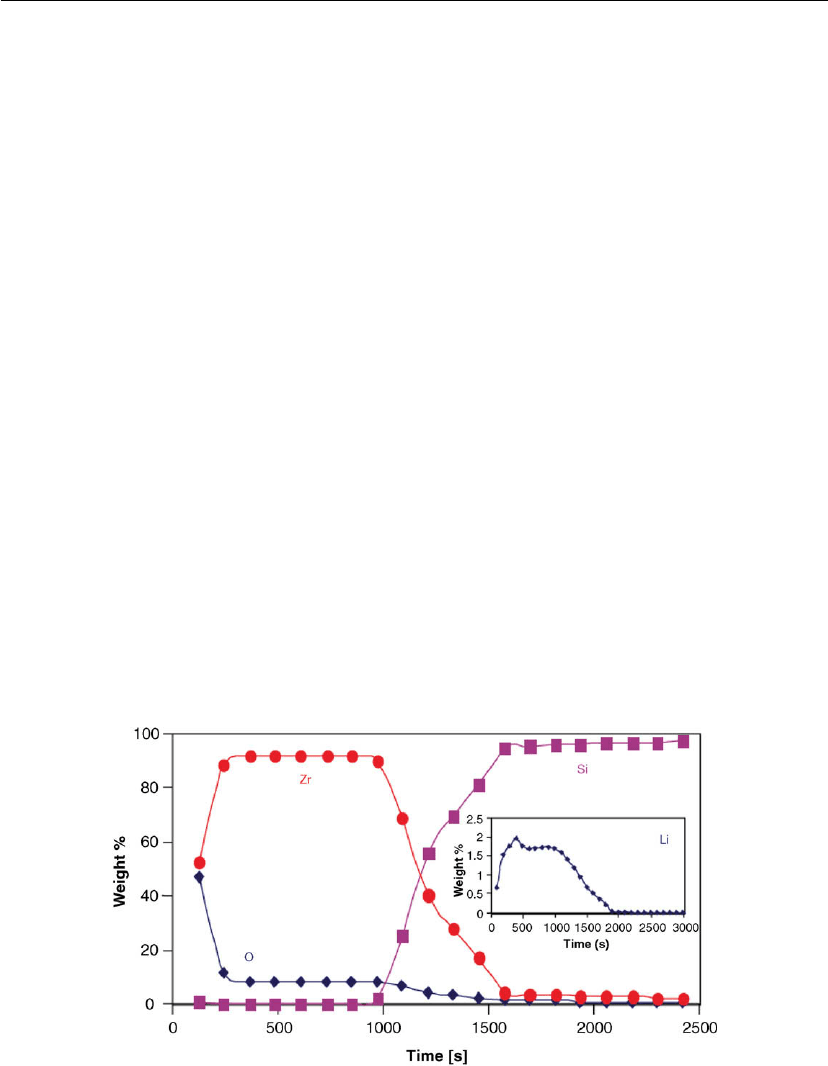
Characterization of Thin Films and Coatings 805
16.4.3 Glow Discharge Mass Spectrometry
GDMS involves the sputtering of a sample by ions accelerated from a low-pressure gas
discharge (plasma) [98]. Similar to SIMS, the method detects species sputtered from the
sample. The method has high sensitivity and dynamic range, but no spatial resolution. It can be
considered as one of the most powerful methods for the determination of trace elements
analysis and depth profiling in bulk materials or thin films.
Typically, Ar is used at pressures ranging from 10 to 100 Pa and Ar
+
ions are accelerated to the
sample with energies of hundreds to thousands of eV. Neutral atoms sputtered from the
sample, which serves as a cathode, are ionized by the plasma and the positively charged ions
are extracted into a mass spectrometer [99, 100]. Because sputtering and ionization occur at
different times and at different locations in the instrument, substrate effects on ion yield (such
as occur for SIMS) are minimized, and calibration and quantification are significantly
simplified. Consequently, GDMS is a useful tool for the measurement of trace composition
and impurities in thin films as well as for obtaining sputter depth profiles. The method has
excellent detection limits (from ppm to ppb) and high dynamic range (allowing bulk, trace
element, and contamination analysis), and can be used for sputter profiling for flat relatively
thick films (∼0.5 to 50 m).
The depth profile of an Li-doped ZrO
2
film grown on a Si substrate is shown in Figure 16.35
[100]. The main profiles highlight the major elements while an insert shows, in some detail,
Figure 16.35: The main plot shows a GDMS depth profile for major elements in a thin layer of
ZrO
2
deposited on Si and doped with Li. The inset highlights the profile of the Li dopant [100].

806 Chapter 16
the concentration of the Li dopant. Betti and de las Heras conducted these measurements as a
part of investigations utilizing GDMS to characterize materials used in nuclear research
including B and Li-doped zircalloy cladding materials. The figure shows weight percentage
profiles of Si, O, and Zr in the film, interface, and substrate Si.
The applications of SIMS and GDMS have been compared as applied for obtaining depth
profiles of hard coatings [101]. The measurements suggest that the resolution for these depth
profiles was as good as or better in GDMS as in SIMS.
Strengths:
Trace element detection in most inorganic materials (all elements except H).
Depth profiling for flat samples detecting major and trace elements.
Sensitivity is mostly insensitive to matrix.
Full element characterization from films, powders, and particulates.
Equal value for conductors and insulators.
Limitations:
Vacuum-compatible materials only.
Not suitable for organics or polymers.
Not sensitive to sample inhomogeneity.
Limited depth resolution (∼1 m).
16.4.4 Dual-Beam FIB/SEM for Thin Film Analysis
L.V. Saraf
For 3D imaging of surfaces and films and to enable preparation of samples for special types of
selected area analysis, it is very useful to combine a FIB (developed from the mid-1970s)
[102–104] with an electron gun as part of a dual-beam FIB/SEM system. Such a dual-beam
instrument typically contains a liquid metal gallium ion source (LMS) that operates at voltages
from 0.5 to 30 kV with a beam size as small as 5 nm, and an electron beam operating at
voltages between 0.35 and 30 kV with a beam diameter of nominally 1 nm. In one commercial
system, as a specific example, these beam columns are angled at 52
◦
to each other. The
focused gallium ion beam provides opportunities for both sample imaging and modification. A
dual-beam FIB/SEM has the ability to acquire high-resolution images while modifying a
sample surface (often by sputtering) with the help of ions. Standalone FIBs and dual-beam
systems have been used for highly efficient selected site TEM sample preparation and in the
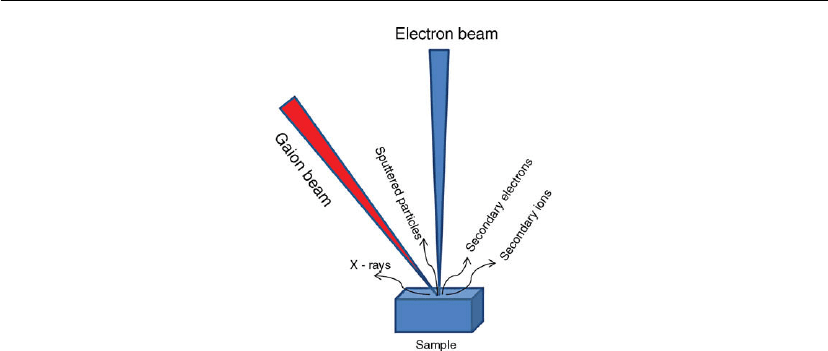
Characterization of Thin Films and Coatings 807
Figure 16.36: A schematic diagram of focused ion beam milling/imaging and scanning electron
microscopy imaging process. The diagram shows the two incident beams and types of particles
and photons emitted from a sample.
semiconductor industry to fix site-specific defects in integrated circuits [105]. As the field
progressed further, additional analysis capabilities were added along with the basic dual beam
to create many useful analysis and sample modification possibilities. Newer capabilities
include sophisticated sample manipulation, gas-phase injection for material deposition, and
analytical capabilities for crystallographic, chemical, and surface analysis. The distance from
the end of the electron beam column to a spot where electron and gallium ion beams cross or
can be focused together is typically noted by the term ‘eccentric height’. Most of the
fundamental physics concepts and fundamental understanding that exist for ion–solid
interactions associated with medium-energy ion implantation, related cascade collisions [106],
and damage created in solids also apply to the FIB/SEM case. The schematic presented in
Figure 16.36 shows the layout of a typical FIB/SEM. Many systems have capabilities for
electron- or ion-induced EDXS and these can be used for ion and electron beam lithography
and ion- and electron beam-induced metal or carbon deposition. FIB/SEM can provide a
powerful method for extraction specimen cross-sections for AES or TEM analysis from
specific areas.
Two applications of the instruments are highlighted here, namely 3D microstructural analysis
ion beam induced imaging.
16.4.4.1 3D Microstructural Analysis
FIB milling of the sample is inherently a damaging process. However, by combining the
precise low-energy sample milling with high-resolution SEM image analysis, one can obtain a
true shape, size distribution, and crystallography of the materials in three dimensions. In many
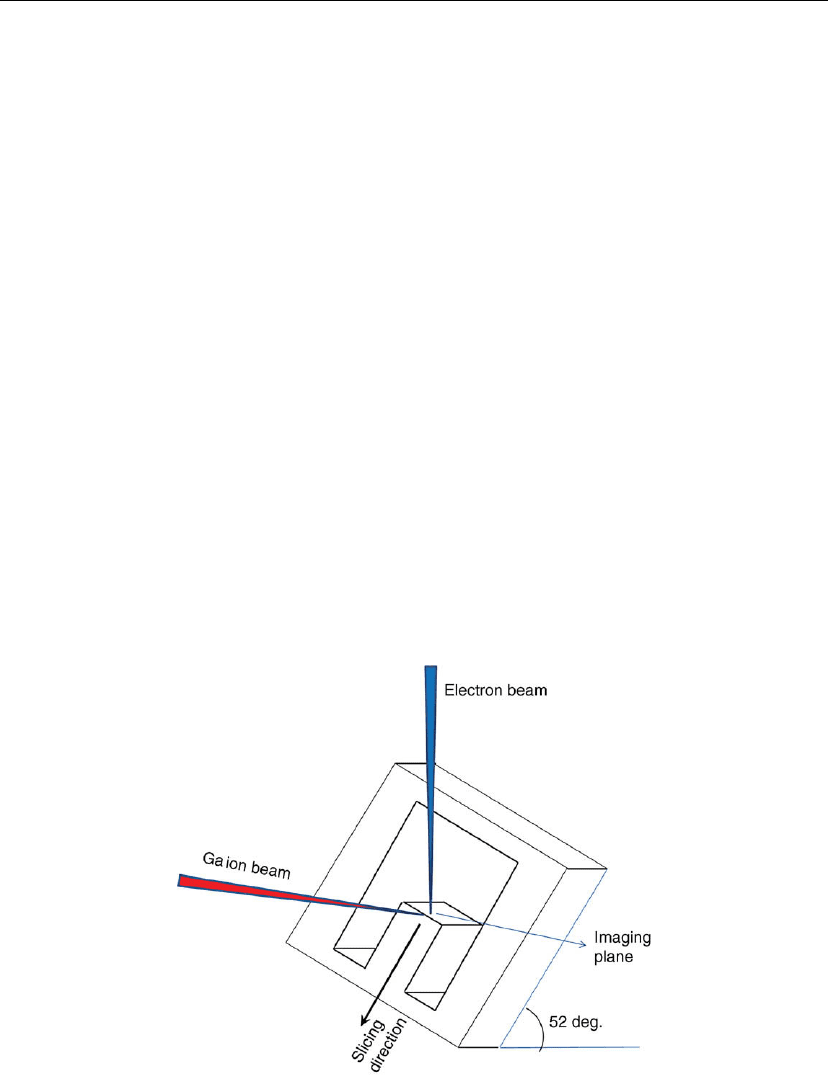
808 Chapter 16
circumstances analysis using 2D imaging suffers from a lack of important information which
can be overcome by 3D analysis. Important information such as number of defects per unit
volume, their connectivity, structural phase transformation, and true shape can only be
obtained by adding analysis in a third dimension. The FIB/SEM, sometimes combined with
electron backscattering diffraction (EBSD), energy-dispersive X-ray spectroscopy (EDXS),
and SEM capabilities, can provide a variety of 3D information. Areas as large as 1 mm
3
can be
precisely analyzed using this combination [107]. This type of imaging is generally called
tomography, which means ‘imaging by sectioning’. A high-energy Ga ion beam (30 kV)
combined with a fine current (typically in ∼ tens of pA) can be used to raster over the desired
sample surface area, which results in controlled sample surface material removal due to
sputtering. The sputtered depths can be controlled as low as 10–15 nm per slice, which is at
least an order of magnitude lower than any mechanically available slicing technique. After
every slice, any one of these capabilities (EBSD, EDXS, or SEM) can be utilized to obtain the
information related to structural, chemical, and surface morphology. Processing several
hundred, up to 1000, frames of data can provide a very accurate picture of the sample,
its defects, porosity, and connectivity in the third dimension. The schematic drawing in
Figure 16.37 indicates typical sample and beam layouts for a tomography experiment. As
shown, the sample is typically tilted to 52
◦
, making the sample surface perpendicular to Ga ion
beam. A large area is removed around the region of interest by ion milling, leaving the desired
area (as shown) intact. Since the ion beam will slice normal to sample surface, thin sections
from the edge are typically sliced all the way to the trench bottom, followed by data collection
and SEM imaging from the sliced side of the rectangle. In this way, SEM imaging is done at a
Figure 16.37: Typical sample layout for tomography experiments in FIB/SEM dual-beam system.
See text for details.
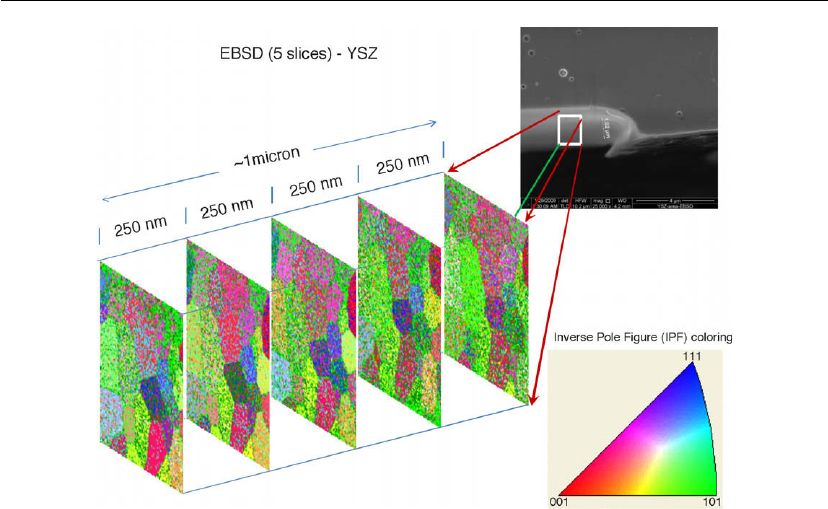
Characterization of Thin Films and Coatings 809
Figure 16.38: Electron backscattered diffraction (EBSD) maps produced after five slices in
yttria-stabilized zirconia (YSZ). The slices in YSZ were made by using a focused ion beam (FIB) in
a dual-beam FIB/SEM.
38
◦
angle. Advanced image processing software programs typically have the ability to
angle-correct image data. If the sample is kept at eccentric height, SEM will image the exact
area sectioned by the ion beam. Using this approach for large area sectioning and imaging
applications, the overall process gets simpler and faster in modern dual-beam systems [108].
Proper care should be taken while using ion beam-sensitive samples because ion beam-induced
damage such as amorphous areas can affect EBSD and other analysis of the data.
An EBSD map produced after five slices in YSZ is shown in Figure 16.38. In this example,
inverse pole-figure grain orientation map along the x-direction in the case of YSZ (a material
frequently used in solid oxide fuel cells) is shown. In general, pole figures in EBSD indicate
crystallographic directions in which grains in a polycrystalline material are distributed,
whereas inverse pole figures show how grains in a selected direction in the polycrystalline
sample are distributed as opposed to the reference frame of the crystal. Since fundamental grain
orientation properties are very important in understanding ionic transport behavior in YSZ, an
inverse pole-figure map can be important in analyzing transport properties of YSZ (in this case
along the x-direction). If YSZ is stabilized in a cubic system, there will be 24 symmetric
sections where the inverse pole-figure information is repeated. However, for interpretation
purposes, information from any one of those 24 symmetric sections can be useful.
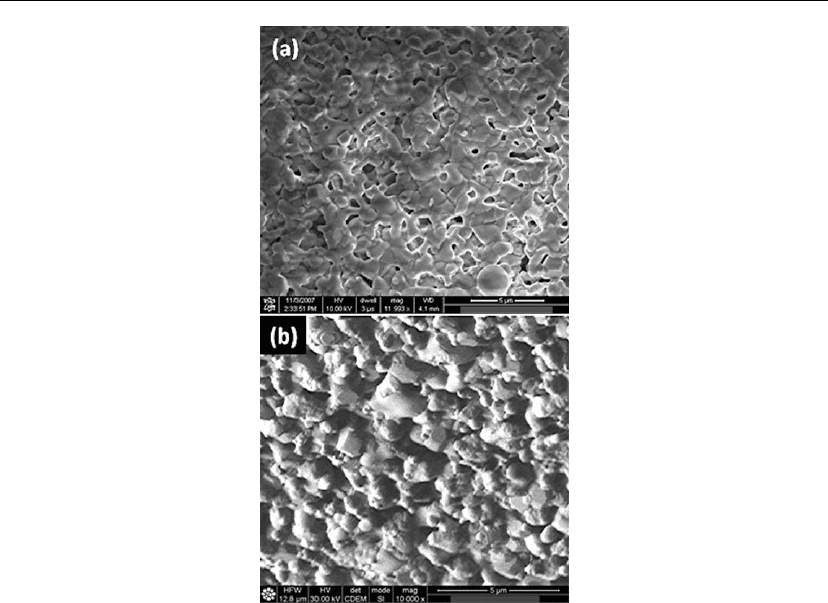
810 Chapter 16
Figure 16.39: An example of Ni-YSZ (a) secondary electron image, and (b) secondary ion image.
The secondary ion image provides better grain contrast and morphology.
16.4.4.2 Ion Beam Induced Imaging
Interaction of the gallium ion beam with the sample surface can generate secondary electrons
which can be readily used to acquire high-resolution images of the sample. These electrons are
generally referred as ion-induced secondary electrons (ISEs) and often provide different image
contrasts in comparison to electron-induced images from an SEM. Figure 16.39 shows a
comparison between SEM and secondary ion imaging of Ni–YSZ. The ISE process typically
generates 1–10 electrons/ion from an ion beam with 5–30 keV energy [109]. These are
primarily low-energy electrons which are usually collected from the first few monolayers of
the sample. Therefore, the nature of the sample surface, its oxidation and gallium
beam-induced surface modifications are heavily expected to affect the rate of electron
emission. It is known that gallium ion beam generated from a liquid metal ion source (LMIS)
can be focused at most to ∼7 nm. Since electron beams can be focused well below 1 nm,
spatial resolution obtained from focused electron beam source is much better than ion beam
source. However, when it comes to imaging the sample surface, ion beams have a unique
advantage, in that the contrast produced by changes in sample topography is much better in ion
beams as a source than electron beams. This is due to the channeling effects produced by ion
